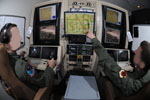More unmanned aircraft pilots being promoted
 The disparity in the promotion rate between pilots of manned and unmanned aircraft has narrowed considerably.
The disparity in the promotion rate between pilots of manned and unmanned aircraft has narrowed considerably.
Some recent promotion boards have selected more unmanned aircraft pilots to advance than mobility pilots, according to figures provided by the Air Force Personnel Center.
Last year, 89 percent of eligible unmanned aircraft pilots were promoted to major, compared with 87.4 percent of mobility pilots, 90.7 percent of bomber pilots and 94.1 percent of fighter pilots, the figures show.
That’s up considerably from 2011, when only 78 percent of eligible unmanned aircraft pilots were selected to advance to major, compared with 90.3 percent of mobility pilots, 92.2 percent of bomber pilots and 92.7 percent of fighter pilots.
Most recently, the 2013 lieutenant colonel promotion board selected 72.2 percent of eligible unmanned aircraft pilots to advance, up from 57.6 percent last year. The 2013 board also selected 70.8 percent of eligible mobility pilots, 86.5 percent of eligible bomber pilots and 85.1 percent of eligible fighter pilots for promotion to lieutenant colonel.
Historically, unmanned aircraft pilots have been promoted less often than mobility, bomber and fighter pilots, prompting Congress to ask the Air Force in December to explain the reasons for the disparity and what the service can do to fix the problems.
Delivered to lawmakers in September, the report determined the surge in demand for unmanned aircraft pilots in recent years outpaced its sourcing system. As a result, unmanned aircraft pilots lagged behind their counterparts in manned aircraft in 20 of 24 promotion cycles between 2006 and 2011.
“In order to meet this demand, the community was required to freeze assignments, mobilize the Air Reserve component, curtail/cancel professional military education (PME) opportunities and delay the standup of normalization initiatives such as the [remotely piloted aircraft] weapons instructor course as part of the U.S. Air Force Weapons School,” the report says.
That means unmanned aircraft pilots do not finish in-residence professional military education as often as manned aircraft pilots do, the report found.
“This is important because in-residence attendance provides officers valuable training and the opportunity to compete for the honor of distinguished graduate or top third,” the report says. “Both of these accomplishments are available for consideration by the promotion board.
In 2011, only 55 percent of captains in the RPA community had completed in-residence Squadron Officer School, compared with the Air Force average of 93 percent.
To remedy some of the problems, the Air Force allocated seats at Squadron Officer School for unmanned aircraft pilots in 2012 and the Air Force secretary has issued guidance to promotion boards that unmanned aircraft pilots may not be as far in their careers or have had the same developmental opportunities as other pilots, the report says.
The report did not say whether any PME slots have been allocated to unmanned aircraft pilots this year. Typically, the Air Force does not assign such slots by weapons system, said Lt. Col Stuart Rubio, chief of rated force policy.
“There was a one-time opportunity in FY12 for ACC [Air Combat Command] to make additional slots available to RPA pilots, but that is not a standard practice,” Rubio said in an email.
One unmanned aircraft pilot, who asked not to be identified, said the recent increase in promotion rates mask the fact that the underlying reasons for the promotions disparity remain.
Even with the extra slots at SOS and guidance from the Air Force secretary, most unmanned aircraft pilots still have fewer opportunities for professional military education, the pilot said. Even those unmanned aircraft pilots promoted to major in 2012 will have fewer career development opportunities by the time they go before their next promotion board.
“You didn’t actually fix why these guys are deficient, you just sent a letter to the [promotion] board saying, ‘Hey, can you promote more of these guys because we look bad,’” the pilot told Air Force Times.
The long term solution for equalizing promotion rates is developing a core of career unmanned aircraft pilots combined with a viable training pipeline and a sustainable operations tempo, the report says.
The 18X career field is meant to do exactly that. Formally established in May 2010, the program graduated 60 officers in 2011, another 102 officers in 2012 and it is expected to produce 168 officers this year.
“As the pipeline expands, the Air Force will also be able to limit the need to fill RPA billets with temporary cross-flows from manned platforms,” the report says. “By fiscal year 2016, 18X officers will be 50 percent of the RPA force. This number increases to 90 percent by fiscal 2022.”